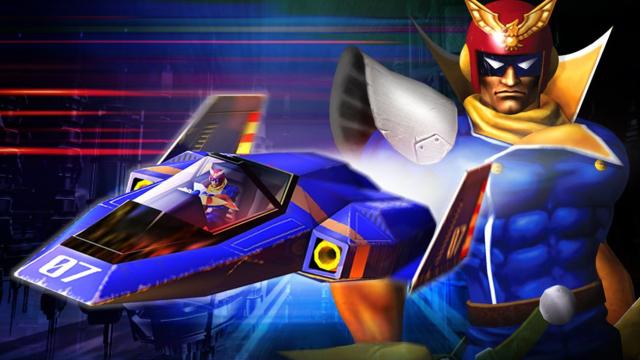The last entry in F-Zero, Nintendo’s antigravity racing series, came out on the Game Boy Advance 17 years ago. The last major console release was F-Zero GX, co-developed with Sega’s Amusement Vision studio in 2003. Despite F-Zero tracks appearing in Mario Kart, and Captain Falcon being a Super Smash Bros. mainstay, Nintendo has exhibited no interest in continuing F-Zero over the last two decades. Fans will have to keep holding their breath.
A while ago, IGN published an excerpt from its interview with retired Nintendo designer Takaya Imamura about F-Zero’s long hiatus. (Please forgive the lateness, but as this is F-Zero we’re talking about, I couldn’t let this news slip by entirely.) IGN asked Imamura if the franchise was truly dead, and he had this to say:
“Of course, I’ve thought about it many times, but without a grand new idea, it’s hard to bring it back.”
The subtext here is that Nintendo tends to design games based on novel gameplay concepts. Unless the company can whip one up for a new F-Zero, it feels it can’t justify bringing the series back. Nintendo obviously has a precedent for revitalizing beloved series with new ideas, The Legend Of Zelda: Breath Of the Wild serving as a prime modern example. I’d personally be satisfied if Nintendo just made an excellent arcade racer again, but that’s apparently not an option. There’s got to be a gimmick.
Alright, fine. So give us a gimmick then.
My main issue with Imamura’s line here — and it’s one Nintendo has parroted before about this franchise — is that it suggests F-Zero not only needs a gimmick to work, but that it’s also inherently immune to creativity. New thinking can’t be applied to it, I suppose because it’s a racing game.
That’s somewhat ironic, because Mario Kart 8 and 8 Deluxe, which recently combined to chart as the best-selling racing game of all time, barely had any new ideas to speak of. Karts change into hovercrafts and gliders mid-race, but those transformations are brief and almost entirely cosmetic; they don’t significantly alter vehicle behaviour or add clever facets to the overall racing. Mario Kart has never really changed all that much, and yet Nintendo still sells loads of those games.
Nevertheless, if the company is convinced F-Zero can’t come back without an ingenious idea, there’s loads of potential in that universe. For one, the plethora of quirky characters makes it ripe for a narrative.
How about having players manage a racing team, like a futuristic version of Grid, recruiting pilots and sponsors? Take inspiration from Splatoon’s squad-based play and Fire Emblem: Three Houses’ extensive team development activities when you’re not battling on track. Give us the bona fide racing RPG nobody else is brave enough to make, just like you’re doing for golf.
Bring back the deep customisation and machine building aspects of F-Zero GX. Study how other games in the genre have kept things fresh with asynchronous objectives and leaderboards that motivate players to constantly top their friends’ times and scores.
I can’t be convinced there’s absolutely nowhere for F-Zero to go. We’ve been through three console generations without a new one, and this medium has evolved leaps and bounds over that time.
It’s especially infuriating for longtime fans because, as Imamura goes on to say, 2003’s F-Zero GX was phenomenal because Sega and Nintendo just made the damn game together — no “grand idea,” no gimmicks. Led by Toshihiro Nagoshi (yes, that Toshihiro Nagoshi, best known today for Yakuza) F-Zero GX was a technical marvel on the GameCube and remains one of the most visceral, dazzling arcade racing experiences to this day. But that wasn’t a big surprise, considering Nagoshi also gave us Virtua Racing, Daytona USA and Scud Race.
Imamura recounted how that game came to be:
“I think it started with [Amusement Vision’s] Toshihiro Nagoshi proposing the project to Miyamoto,” says Imamura. “I really liked Daytona USA (which Nagoshi produced), so I was honoured to work with him. We had an arcade system board called Triforce which was based on the GameCube’s architecture, so when Nagoshi proposed doing an arcade version of F-Zero, I was really happy, as I had always been a fan of arcade games.
“Back then, Nagoshi was the top of Amusement Vision, a subsidiary studio of Sega. I don’t think many people outside the company were ever allowed inside the actual development offices. Companies don’t usually let people inside their development offices, but they showed me the arcade cabinets they were working on, which has become a special memory for me,” recalls Imamura. “Nagoshi had a professional darts machine in his office, which I thought was very stylish. In those days, Nagoshi still had long hair, but he was already quite imposing.”
You can tell there’s still a reverence for F-Zero GX by those who worked on it, including Nagoshi himself. It’s hard to make a business case for a game that has a relatively small but extremely passionate and vocal cult of fans, though F-Zero has been away for so long that I can’t help but believe a new entry wouldn’t flounder, especially with all the love for Nintendo and the Switch out there today. Maybe just give us a remaster of GX to gauge reception, first? Honestly at this point, I’ll settle for anything.

Comments